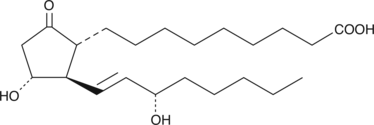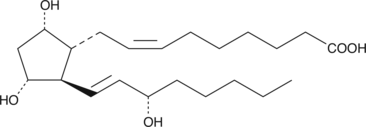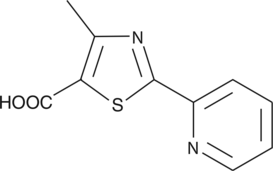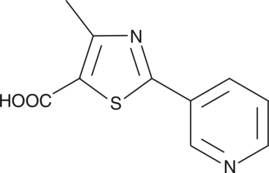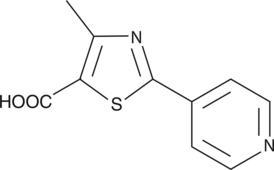Chemicals
Showing 4051–4200 of 41137 results
-
19R(20S)-EpDPA is an oxylipin and a metabolite of docosahexaenoic acid (DHA; Item No. 90310).{46813,48940} It is formed from DHA by various cytochrome P450 (CYP) isoforms in a stereoselective manner.{48940} 19R(20S)-EpDPA (30 nM) prevents calcium-induced increases in the spontaneous beating of isolated neonatal rat cardiomyocytes (NRCMs).{18627}
Brand:CaymanSKU:28628 - 50 µgAvailable on backorder
19R(20S)-EpDPA is an oxylipin and a metabolite of docosahexaenoic acid (DHA; Item No. 90310).{46813,48940} It is formed from DHA by various cytochrome P450 (CYP) isoforms in a stereoselective manner.{48940} 19R(20S)-EpDPA (30 nM) prevents calcium-induced increases in the spontaneous beating of isolated neonatal rat cardiomyocytes (NRCMs).{18627}
Brand:CaymanSKU:28628 - 500 µgAvailable on backorder
Prostaglandin E1 (PGE1) is not a major naturally occurring PG, but is widely administered clinically for several indications including peripheral occlusive vascular disease, erectile dysfunction, and in neonatal cardiology.{22,3803} COX metabolism of the unusual fatty acid 10,13,16-docosatrienoic acid yields 1a,1b-dihomo PGE1. This rare metabolite has been recovered from incubations of whole sheep seminal vesicles, but has not been reported in humans.{11211} In ex vivo preparations of rat aorta and rat PRP, 1a,1b-dihomo PGE1 was found to be much less active than PGE1 itself.{11212}
Brand:CaymanSKU:13050 - 1 mgAvailable on backorder
Prostaglandin E1 (PGE1) is not a major naturally occurring PG, but is widely administered clinically for several indications including peripheral occlusive vascular disease, erectile dysfunction, and in neonatal cardiology.{22,3803} COX metabolism of the unusual fatty acid 10,13,16-docosatrienoic acid yields 1a,1b-dihomo PGE1. This rare metabolite has been recovered from incubations of whole sheep seminal vesicles, but has not been reported in humans.{11211} In ex vivo preparations of rat aorta and rat PRP, 1a,1b-dihomo PGE1 was found to be much less active than PGE1 itself.{11212}
Brand:CaymanSKU:13050 - 10 mgAvailable on backorder
Prostaglandin E1 (PGE1) is not a major naturally occurring PG, but is widely administered clinically for several indications including peripheral occlusive vascular disease, erectile dysfunction, and in neonatal cardiology.{22,3803} COX metabolism of the unusual fatty acid 10,13,16-docosatrienoic acid yields 1a,1b-dihomo PGE1. This rare metabolite has been recovered from incubations of whole sheep seminal vesicles, but has not been reported in humans.{11211} In ex vivo preparations of rat aorta and rat PRP, 1a,1b-dihomo PGE1 was found to be much less active than PGE1 itself.{11212}
Brand:CaymanSKU:13050 - 5 mgAvailable on backorder
1a,1b-dihomo Prostaglandin E2 (PGE2) is a rare polyunsaturated fatty acid first identified in extracts of sheep vesicular gland microsomes, known to contain COX, incubated with adrenic acid (Item No. 90300).{21156} 1a,1b-dihomo PGE2 has also been identified in conditioned media of RAW 264.7 macrophages stimulated with endotoxin and arachidonic acid (AA; Item No. 90010).{14665} This product is thought to be produced by elongation of AA to adrenic acid, which is then metabolized sequentially by COX and PGE synthase.{14665}
Brand:CaymanSKU:-Available on backorder
1a,1b-dihomo Prostaglandin E2 (PGE2) is a rare polyunsaturated fatty acid first identified in extracts of sheep vesicular gland microsomes, known to contain COX, incubated with adrenic acid (Item No. 90300).{21156} 1a,1b-dihomo PGE2 has also been identified in conditioned media of RAW 264.7 macrophages stimulated with endotoxin and arachidonic acid (AA; Item No. 90010).{14665} This product is thought to be produced by elongation of AA to adrenic acid, which is then metabolized sequentially by COX and PGE synthase.{14665}
Brand:CaymanSKU:-Available on backorder
1a,1b-dihomo Prostaglandin E2 (PGE2) is a rare polyunsaturated fatty acid first identified in extracts of sheep vesicular gland microsomes, known to contain COX, incubated with adrenic acid (Item No. 90300).{21156} 1a,1b-dihomo PGE2 has also been identified in conditioned media of RAW 264.7 macrophages stimulated with endotoxin and arachidonic acid (AA; Item No. 90010).{14665} This product is thought to be produced by elongation of AA to adrenic acid, which is then metabolized sequentially by COX and PGE synthase.{14665}
Brand:CaymanSKU:-Available on backorder
1a,1b-dihomo Prostaglandin F2α (1a,1b-dihomo PGF2α) is the theoretical product of adrenic acid in the COX pathway.{2047,1288} 1a,1b-dihomo PGF2α is primarily produced in renal medulla where adrenic acid is selectively distributed.{1288}
Brand:CaymanSKU:-1a,1b-dihomo Prostaglandin F2α (1a,1b-dihomo PGF2α) is the theoretical product of adrenic acid in the COX pathway.{2047,1288} 1a,1b-dihomo PGF2α is primarily produced in renal medulla where adrenic acid is selectively distributed.{1288}
Brand:CaymanSKU:-1a,1b-dihomo Prostaglandin F2α (1a,1b-dihomo PGF2α) is the theoretical product of adrenic acid in the COX pathway.{2047,1288} 1a,1b-dihomo PGF2α is primarily produced in renal medulla where adrenic acid is selectively distributed.{1288}
Brand:CaymanSKU:-Candesartan cilexetil (Item No. 10489) is a prodrug of the potent, long-acting, and selective angiotensin II type 1 receptor (AT1) antagonist, candesartan. Clinical trials indicate a 4-16 mg/day dose of candesartan cilexetil effectively reduces diastolic blood pressure.{18425} 1H-1-ethyl Candesartan cilexetil is a process-related impurity commonly found in the bulk synthesis of candesartan cilexetil.{29093}
Brand:CaymanSKU:-Available on backorder
Candesartan cilexetil (Item No. 10489) is a prodrug of the potent, long-acting, and selective angiotensin II type 1 receptor (AT1) antagonist, candesartan. Clinical trials indicate a 4-16 mg/day dose of candesartan cilexetil effectively reduces diastolic blood pressure.{18425} 1H-1-ethyl Candesartan cilexetil is a process-related impurity commonly found in the bulk synthesis of candesartan cilexetil.{29093}
Brand:CaymanSKU:-Available on backorder
Candesartan cilexetil (Item No. 10489) is a prodrug of the potent, long-acting, and selective angiotensin II type 1 receptor (AT1) antagonist, candesartan. Clinical trials indicate a 4-16 mg/day dose of candesartan cilexetil effectively reduces diastolic blood pressure.{18425} 1H-1-ethyl Candesartan cilexetil is a process-related impurity commonly found in the bulk synthesis of candesartan cilexetil.{29093}
Brand:CaymanSKU:-Available on backorder
1β-Acetoxypolygodial is a sesquiterpenoid that has been found in T. lanceolata and has antiprotozoal activity.{53304,53305} It is active against T. cruzi amastigotes and trypomastigotes (GI50s = 57.8 and 72 µM, respectively) but not T. cruzi epimastigotes (GI50 = >100 µM).{53305}
Brand:CaymanSKU:29901 - 1 mgAvailable on backorder
1β-Acetoxypolygodial is a sesquiterpenoid that has been found in T. lanceolata and has antiprotozoal activity.{53304,53305} It is active against T. cruzi amastigotes and trypomastigotes (GI50s = 57.8 and 72 µM, respectively) but not T. cruzi epimastigotes (GI50 = >100 µM).{53305}
Brand:CaymanSKU:29901 - 5 mgAvailable on backorder
2-(1-(Thiophen-2-yl)ethylidene)hydrazinecarbothioamide is an antimicrobial agent.{58140} It is active against the Gram-negative bacteria E. coli, P. aeruginosa, and S. marcescens (MICs = 64, 100, and 70 μg/ml, respectively), the Gram-positive bacteria S. aureus, M. luteus, and B. cereus (MICs = 130, 100, and 50 μg/ml, respectively), and the fungi C. albicans, G. candidum, T. rubrum, F. oxysporum, A. flavus, and S. brevicaulis (MICs = 69-120 μg/ml). 2-(1-(Thiophen-2-yl)ethylidene)hydrazinecarbothioamide is also a precursor in the synthesis of other antimicrobial agents, as well as compounds with anticancer activity.{58140,58141}
Brand:CaymanSKU:31385 - 10 mgAvailable on backorder
2-(1-(Thiophen-2-yl)ethylidene)hydrazinecarbothioamide is an antimicrobial agent.{58140} It is active against the Gram-negative bacteria E. coli, P. aeruginosa, and S. marcescens (MICs = 64, 100, and 70 μg/ml, respectively), the Gram-positive bacteria S. aureus, M. luteus, and B. cereus (MICs = 130, 100, and 50 μg/ml, respectively), and the fungi C. albicans, G. candidum, T. rubrum, F. oxysporum, A. flavus, and S. brevicaulis (MICs = 69-120 μg/ml). 2-(1-(Thiophen-2-yl)ethylidene)hydrazinecarbothioamide is also a precursor in the synthesis of other antimicrobial agents, as well as compounds with anticancer activity.{58140,58141}
Brand:CaymanSKU:31385 - 25 mgAvailable on backorder
2-(1-(Thiophen-2-yl)ethylidene)hydrazinecarbothioamide is an antimicrobial agent.{58140} It is active against the Gram-negative bacteria E. coli, P. aeruginosa, and S. marcescens (MICs = 64, 100, and 70 μg/ml, respectively), the Gram-positive bacteria S. aureus, M. luteus, and B. cereus (MICs = 130, 100, and 50 μg/ml, respectively), and the fungi C. albicans, G. candidum, T. rubrum, F. oxysporum, A. flavus, and S. brevicaulis (MICs = 69-120 μg/ml). 2-(1-(Thiophen-2-yl)ethylidene)hydrazinecarbothioamide is also a precursor in the synthesis of other antimicrobial agents, as well as compounds with anticancer activity.{58140,58141}
Brand:CaymanSKU:31385 - 5 mgAvailable on backorder
2-(1-(Thiophen-2-yl)ethylidene)hydrazinecarbothioamide is an antimicrobial agent.{58140} It is active against the Gram-negative bacteria E. coli, P. aeruginosa, and S. marcescens (MICs = 64, 100, and 70 μg/ml, respectively), the Gram-positive bacteria S. aureus, M. luteus, and B. cereus (MICs = 130, 100, and 50 μg/ml, respectively), and the fungi C. albicans, G. candidum, T. rubrum, F. oxysporum, A. flavus, and S. brevicaulis (MICs = 69-120 μg/ml). 2-(1-(Thiophen-2-yl)ethylidene)hydrazinecarbothioamide is also a precursor in the synthesis of other antimicrobial agents, as well as compounds with anticancer activity.{58140,58141}
Brand:CaymanSKU:31385 - 50 mgAvailable on backorder
2-(1,8-Naphthyridin-2-yl)phenol (2-NP) is an enhancer of STAT1 activity.{56126} It enhances IFN-γ-induced STAT1-dependent signaling, but not IFN-γ-induced STAT3-dependent signaling or TNF-α-induced NF-κB-dependent signaling in cell-based reporter assays when used at a concentration of 45 µM. 2-NP (45 µM) increases IFN-γ-induced expression of the STAT1 target gene IRF3 and STAT1 phosphorylation in NIH3T3 cells. It increases growth inhibition of MCF-7 and 2fTGH cancer cells induced by IFN-γ at the same concentration.
Brand:CaymanSKU:30918 - 10 mgAvailable on backorder
2-(1,8-Naphthyridin-2-yl)phenol (2-NP) is an enhancer of STAT1 activity.{56126} It enhances IFN-γ-induced STAT1-dependent signaling, but not IFN-γ-induced STAT3-dependent signaling or TNF-α-induced NF-κB-dependent signaling in cell-based reporter assays when used at a concentration of 45 µM. 2-NP (45 µM) increases IFN-γ-induced expression of the STAT1 target gene IRF3 and STAT1 phosphorylation in NIH3T3 cells. It increases growth inhibition of MCF-7 and 2fTGH cancer cells induced by IFN-γ at the same concentration.
Brand:CaymanSKU:30918 - 25 mgAvailable on backorder
2-(1,8-Naphthyridin-2-yl)phenol (2-NP) is an enhancer of STAT1 activity.{56126} It enhances IFN-γ-induced STAT1-dependent signaling, but not IFN-γ-induced STAT3-dependent signaling or TNF-α-induced NF-κB-dependent signaling in cell-based reporter assays when used at a concentration of 45 µM. 2-NP (45 µM) increases IFN-γ-induced expression of the STAT1 target gene IRF3 and STAT1 phosphorylation in NIH3T3 cells. It increases growth inhibition of MCF-7 and 2fTGH cancer cells induced by IFN-γ at the same concentration.
Brand:CaymanSKU:30918 - 5 mgAvailable on backorder
2-(1,8-Naphthyridin-2-yl)phenol (2-NP) is an enhancer of STAT1 activity.{56126} It enhances IFN-γ-induced STAT1-dependent signaling, but not IFN-γ-induced STAT3-dependent signaling or TNF-α-induced NF-κB-dependent signaling in cell-based reporter assays when used at a concentration of 45 µM. 2-NP (45 µM) increases IFN-γ-induced expression of the STAT1 target gene IRF3 and STAT1 phosphorylation in NIH3T3 cells. It increases growth inhibition of MCF-7 and 2fTGH cancer cells induced by IFN-γ at the same concentration.
Brand:CaymanSKU:30918 - 50 mgAvailable on backorder
2-(2-Chlorophenyl)-2-hydroxycyclohexanone (Item No. 9003366) is an analytical reference standard that is structurally similar to known hallucinogens. It is a potential impurity in esketamine preparations.{58115} This product is intended for research and forensic applications.
Brand:CaymanSKU:9003366 - 1 mgAvailable on backorder
2-(2-Chlorophenyl)-2-hydroxycyclohexanone (Item No. 9003366) is an analytical reference standard that is structurally similar to known hallucinogens. It is a potential impurity in esketamine preparations.{58115} This product is intended for research and forensic applications.
Brand:CaymanSKU:9003366 - 5 mgAvailable on backorder
2-(2-pyridyl)-4-methyl-Thiazole-5-carboxylic acid is a synthetic intermediate useful for pharmaceutical synthesis.
Brand:CaymanSKU:13047 - 1 gAvailable on backorder
2-(2-pyridyl)-4-methyl-Thiazole-5-carboxylic acid is a synthetic intermediate useful for pharmaceutical synthesis.
Brand:CaymanSKU:13047 - 100 mgAvailable on backorder
2-(2-pyridyl)-4-methyl-Thiazole-5-carboxylic acid is a synthetic intermediate useful for pharmaceutical synthesis.
Brand:CaymanSKU:13047 - 250 mgAvailable on backorder
2-(2-pyridyl)-4-methyl-Thiazole-5-carboxylic acid is a synthetic intermediate useful for pharmaceutical synthesis.
Brand:CaymanSKU:13047 - 500 mgAvailable on backorder
2-(3-pyridyl)-4-methyl-Thiazole-5-carboxylic acid is a synthetic intermediate useful for pharmaceutical synthesis.
Brand:CaymanSKU:13036 - 1 gAvailable on backorder
2-(3-pyridyl)-4-methyl-Thiazole-5-carboxylic acid is a synthetic intermediate useful for pharmaceutical synthesis.
Brand:CaymanSKU:13036 - 100 mgAvailable on backorder
2-(3-pyridyl)-4-methyl-Thiazole-5-carboxylic acid is a synthetic intermediate useful for pharmaceutical synthesis.
Brand:CaymanSKU:13036 - 250 mgAvailable on backorder
2-(3-pyridyl)-4-methyl-Thiazole-5-carboxylic acid is a synthetic intermediate useful for pharmaceutical synthesis.
Brand:CaymanSKU:13036 - 500 mgAvailable on backorder
Brand:CaymanSKU:13054 - 1 gAvailable on backorder
Brand:CaymanSKU:13054 - 5 gAvailable on backorder
Brand:CaymanSKU:13054 - 500 mgAvailable on backorder
2-(4-Fluorophenyl)piperazine (Item No. 24421) is an analytical reference standard categorized as a piperazine. This product is intended for research and forensic applications.
Brand:CaymanSKU:24421 - 1 mgAvailable on backorder
2-(4-Fluorophenyl)piperazine (Item No. 24421) is an analytical reference standard categorized as a piperazine. This product is intended for research and forensic applications.
Brand:CaymanSKU:24421 - 5 mgAvailable on backorder
2-(4-pyridyl)-4-methyl-Thiazole-5-carboxylic acid is a synthetic intermediate useful for pharmaceutical synthesis.
Brand:CaymanSKU:13049 - 1 gAvailable on backorder
2-(4-pyridyl)-4-methyl-Thiazole-5-carboxylic acid is a synthetic intermediate useful for pharmaceutical synthesis.
Brand:CaymanSKU:13049 - 100 mgAvailable on backorder
2-(4-pyridyl)-4-methyl-Thiazole-5-carboxylic acid is a synthetic intermediate useful for pharmaceutical synthesis.
Brand:CaymanSKU:13049 - 250 mgAvailable on backorder
2-(4-pyridyl)-4-methyl-Thiazole-5-carboxylic acid is a synthetic intermediate useful for pharmaceutical synthesis.
Brand:CaymanSKU:13049 - 500 mgAvailable on backorder
2-(chloromethyl)-Pyrimidine (hydrochloride) is a synthetic intermediate useful for pharmaceutical synthesis.
Brand:CaymanSKU:10007122 - 1 gAvailable on backorder
2-(chloromethyl)-Pyrimidine (hydrochloride) is a synthetic intermediate useful for pharmaceutical synthesis.
Brand:CaymanSKU:10007122 - 100 mgAvailable on backorder
2-(chloromethyl)-Pyrimidine (hydrochloride) is a synthetic intermediate useful for pharmaceutical synthesis.
Brand:CaymanSKU:10007122 - 50 mgAvailable on backorder
2-(chloromethyl)-Pyrimidine (hydrochloride) is a synthetic intermediate useful for pharmaceutical synthesis.
Brand:CaymanSKU:10007122 - 500 mgAvailable on backorder
Brand:CaymanSKU:10007112 - 1 gAvailable on backorder
Brand:CaymanSKU:10007112 - 100 mgAvailable on backorder
Brand:CaymanSKU:10007112 - 50 mgAvailable on backorder
Brand:CaymanSKU:10007112 - 500 mgAvailable on backorder
2-(Isopentylamino)naphthalene-1,4-dione is a vitamin K analog.{54481} It inhibits spasms induced by pentylenetetrazole (PTZ; Item No. 18682) and tonic hindlimb extension induced by maximal electroshock (MES) in mice (ED50s = 349.2 and 108.1 mg/kg, respectively). It also protects mice against seizures in the 6 Hz psychomotor seizure test (ED50s = 152.7 and 263.7 mg/kg at stimulus intensities of 32 and 44 mA, respectively).
Brand:CaymanSKU:31107 - 1 mgAvailable on backorder
2-(Isopentylamino)naphthalene-1,4-dione is a vitamin K analog.{54481} It inhibits spasms induced by pentylenetetrazole (PTZ; Item No. 18682) and tonic hindlimb extension induced by maximal electroshock (MES) in mice (ED50s = 349.2 and 108.1 mg/kg, respectively). It also protects mice against seizures in the 6 Hz psychomotor seizure test (ED50s = 152.7 and 263.7 mg/kg at stimulus intensities of 32 and 44 mA, respectively).
Brand:CaymanSKU:31107 - 10 mgAvailable on backorder
2-(Isopentylamino)naphthalene-1,4-dione is a vitamin K analog.{54481} It inhibits spasms induced by pentylenetetrazole (PTZ; Item No. 18682) and tonic hindlimb extension induced by maximal electroshock (MES) in mice (ED50s = 349.2 and 108.1 mg/kg, respectively). It also protects mice against seizures in the 6 Hz psychomotor seizure test (ED50s = 152.7 and 263.7 mg/kg at stimulus intensities of 32 and 44 mA, respectively).
Brand:CaymanSKU:31107 - 25 mgAvailable on backorder
2-(Isopentylamino)naphthalene-1,4-dione is a vitamin K analog.{54481} It inhibits spasms induced by pentylenetetrazole (PTZ; Item No. 18682) and tonic hindlimb extension induced by maximal electroshock (MES) in mice (ED50s = 349.2 and 108.1 mg/kg, respectively). It also protects mice against seizures in the 6 Hz psychomotor seizure test (ED50s = 152.7 and 263.7 mg/kg at stimulus intensities of 32 and 44 mA, respectively).
Brand:CaymanSKU:31107 - 5 mgAvailable on backorder
2-(Phosphonomethyl)-pentanedioic acid (2-PMPA) is a potent inhibitor of glutamate carboxypeptidase II (GCP II), also known as N-acetylated α-linked dipeptidase (NAALADase), with a Ki value of 98 pM for release of glutamate from the NAALADase peptide substrate N-acetylasparatylglutamate (NAAG).{38879} It is selective for GCP II/NAALADase over a panel of 100 receptors, transporters, ion channels, and enzymes at a concentration of 10 μM.{7392} 2-PMPA is neuroprotective against hypoxia (EC50 = 8.4 μM), but not veratridine-induced injury, in neuron-enriched primary cultures from rat embryo cerebellum.{38880} In vivo, 2-PMPA reduces neuronal cell death induced by middle cerebral artery occlusion via increases in NAAG expression and reduction of glutamate in rats.{7392} 2-PMPA (100 mg/kg) blocks the conditioned place preference response to cocaine, but not food, in male rats.{38881} It reduces the number of flinches induced by formalin injection into the footpad of mice when administered at a dose of 10 μg per animal, an effect that is reversed by the group II metabotropic glutamate receptor antagonist LY341495.{38878} 2-PMPA also decreases severity and delays onset of experimental autoimmune encephalomyelitis (EAE) in mice.{38882}
Brand:CaymanSKU:21916 -Out of stock
2-(Phosphonomethyl)-pentanedioic acid (2-PMPA) is a potent inhibitor of glutamate carboxypeptidase II (GCP II), also known as N-acetylated α-linked dipeptidase (NAALADase), with a Ki value of 98 pM for release of glutamate from the NAALADase peptide substrate N-acetylasparatylglutamate (NAAG).{38879} It is selective for GCP II/NAALADase over a panel of 100 receptors, transporters, ion channels, and enzymes at a concentration of 10 μM.{7392} 2-PMPA is neuroprotective against hypoxia (EC50 = 8.4 μM), but not veratridine-induced injury, in neuron-enriched primary cultures from rat embryo cerebellum.{38880} In vivo, 2-PMPA reduces neuronal cell death induced by middle cerebral artery occlusion via increases in NAAG expression and reduction of glutamate in rats.{7392} 2-PMPA (100 mg/kg) blocks the conditioned place preference response to cocaine, but not food, in male rats.{38881} It reduces the number of flinches induced by formalin injection into the footpad of mice when administered at a dose of 10 μg per animal, an effect that is reversed by the group II metabotropic glutamate receptor antagonist LY341495.{38878} 2-PMPA also decreases severity and delays onset of experimental autoimmune encephalomyelitis (EAE) in mice.{38882}
Brand:CaymanSKU:21916 -Out of stock
2-(Phosphonomethyl)-pentanedioic acid (2-PMPA) is a potent inhibitor of glutamate carboxypeptidase II (GCP II), also known as N-acetylated α-linked dipeptidase (NAALADase), with a Ki value of 98 pM for release of glutamate from the NAALADase peptide substrate N-acetylasparatylglutamate (NAAG).{38879} It is selective for GCP II/NAALADase over a panel of 100 receptors, transporters, ion channels, and enzymes at a concentration of 10 μM.{7392} 2-PMPA is neuroprotective against hypoxia (EC50 = 8.4 μM), but not veratridine-induced injury, in neuron-enriched primary cultures from rat embryo cerebellum.{38880} In vivo, 2-PMPA reduces neuronal cell death induced by middle cerebral artery occlusion via increases in NAAG expression and reduction of glutamate in rats.{7392} 2-PMPA (100 mg/kg) blocks the conditioned place preference response to cocaine, but not food, in male rats.{38881} It reduces the number of flinches induced by formalin injection into the footpad of mice when administered at a dose of 10 μg per animal, an effect that is reversed by the group II metabotropic glutamate receptor antagonist LY341495.{38878} 2-PMPA also decreases severity and delays onset of experimental autoimmune encephalomyelitis (EAE) in mice.{38882}
Brand:CaymanSKU:21916 -Out of stock
2-(Phosphonomethyl)-pentanedioic acid (2-PMPA) is a potent inhibitor of glutamate carboxypeptidase II (GCP II), also known as N-acetylated α-linked dipeptidase (NAALADase), with a Ki value of 98 pM for release of glutamate from the NAALADase peptide substrate N-acetylasparatylglutamate (NAAG).{38879} It is selective for GCP II/NAALADase over a panel of 100 receptors, transporters, ion channels, and enzymes at a concentration of 10 μM.{7392} 2-PMPA is neuroprotective against hypoxia (EC50 = 8.4 μM), but not veratridine-induced injury, in neuron-enriched primary cultures from rat embryo cerebellum.{38880} In vivo, 2-PMPA reduces neuronal cell death induced by middle cerebral artery occlusion via increases in NAAG expression and reduction of glutamate in rats.{7392} 2-PMPA (100 mg/kg) blocks the conditioned place preference response to cocaine, but not food, in male rats.{38881} It reduces the number of flinches induced by formalin injection into the footpad of mice when administered at a dose of 10 μg per animal, an effect that is reversed by the group II metabotropic glutamate receptor antagonist LY341495.{38878} 2-PMPA also decreases severity and delays onset of experimental autoimmune encephalomyelitis (EAE) in mice.{38882}
Brand:CaymanSKU:21916 -Out of stock
2-Acetamidophenyl 5-chloro-2-nitrophenyl sulfide is a sulfide-like inhibitor of phosphodiesterase 7 (PDE7; IC50 = 2.1 µM).{29363} It is selective for PDE7A, producing only 10-11% inhibition of PDE3A, PDE4D, and PDE4B at 10 µM.{29363} It also has no antioxidant activity or inhibitory activity against a panel of protein kinases.{29363} Sulfide-like PDE7 inhibitors derived from 2-acetamidophenyl 5-chloro-2-nitrophenyl sulfide have cytoprotective and anti-inflammatory effects on SH-SY5Y neuroblastoma cells without action in a surrogate emesis mouse model.{29363}
Brand:CaymanSKU:-Available on backorder
2-Acetamidophenyl 5-chloro-2-nitrophenyl sulfide is a sulfide-like inhibitor of phosphodiesterase 7 (PDE7; IC50 = 2.1 µM).{29363} It is selective for PDE7A, producing only 10-11% inhibition of PDE3A, PDE4D, and PDE4B at 10 µM.{29363} It also has no antioxidant activity or inhibitory activity against a panel of protein kinases.{29363} Sulfide-like PDE7 inhibitors derived from 2-acetamidophenyl 5-chloro-2-nitrophenyl sulfide have cytoprotective and anti-inflammatory effects on SH-SY5Y neuroblastoma cells without action in a surrogate emesis mouse model.{29363}
Brand:CaymanSKU:-Available on backorder
2-Acetamidophenyl 5-chloro-2-nitrophenyl sulfide is a sulfide-like inhibitor of phosphodiesterase 7 (PDE7; IC50 = 2.1 µM).{29363} It is selective for PDE7A, producing only 10-11% inhibition of PDE3A, PDE4D, and PDE4B at 10 µM.{29363} It also has no antioxidant activity or inhibitory activity against a panel of protein kinases.{29363} Sulfide-like PDE7 inhibitors derived from 2-acetamidophenyl 5-chloro-2-nitrophenyl sulfide have cytoprotective and anti-inflammatory effects on SH-SY5Y neuroblastoma cells without action in a surrogate emesis mouse model.{29363}
Brand:CaymanSKU:-Available on backorder
2-Acetamidophenyl 5-chloro-2-nitrophenyl sulfide is a sulfide-like inhibitor of phosphodiesterase 7 (PDE7; IC50 = 2.1 µM).{29363} It is selective for PDE7A, producing only 10-11% inhibition of PDE3A, PDE4D, and PDE4B at 10 µM.{29363} It also has no antioxidant activity or inhibitory activity against a panel of protein kinases.{29363} Sulfide-like PDE7 inhibitors derived from 2-acetamidophenyl 5-chloro-2-nitrophenyl sulfide have cytoprotective and anti-inflammatory effects on SH-SY5Y neuroblastoma cells without action in a surrogate emesis mouse model.{29363}
Brand:CaymanSKU:-Available on backorder
2-Acetyl-5-tetrahydroxybutyl imidazole (THI) is an inhibitor of sphingosine-1-phosphate (S1P) lyase in vivo.{13428} THI is not active at S1P lyase in cell-free or cell-based assays but is converted to A6770 in vivo, which is subsequently activated by phosphorylation.{45874} In mice, THI (50 µg/ml in drinking water) increases S1P levels by 100-fold in lymphoid tissue and reduces lymphocyte egress from thymus and peripheral lymphoid organs.{13428,17443} The resulting lymphopenia is reversible following cessation of THI treatment.{17442}
Brand:CaymanSKU:-2-Acetyl-5-tetrahydroxybutyl imidazole (THI) is an inhibitor of sphingosine-1-phosphate (S1P) lyase in vivo.{13428} THI is not active at S1P lyase in cell-free or cell-based assays but is converted to A6770 in vivo, which is subsequently activated by phosphorylation.{45874} In mice, THI (50 µg/ml in drinking water) increases S1P levels by 100-fold in lymphoid tissue and reduces lymphocyte egress from thymus and peripheral lymphoid organs.{13428,17443} The resulting lymphopenia is reversible following cessation of THI treatment.{17442}
Brand:CaymanSKU:-2-Acetyl-5-tetrahydroxybutyl imidazole (THI) is an inhibitor of sphingosine-1-phosphate (S1P) lyase in vivo.{13428} THI is not active at S1P lyase in cell-free or cell-based assays but is converted to A6770 in vivo, which is subsequently activated by phosphorylation.{45874} In mice, THI (50 µg/ml in drinking water) increases S1P levels by 100-fold in lymphoid tissue and reduces lymphocyte egress from thymus and peripheral lymphoid organs.{13428,17443} The resulting lymphopenia is reversible following cessation of THI treatment.{17442}
Brand:CaymanSKU:-2-Acetyl-5-tetrahydroxybutyl imidazole (THI) is an inhibitor of sphingosine-1-phosphate (S1P) lyase in vivo.{13428} THI is not active at S1P lyase in cell-free or cell-based assays but is converted to A6770 in vivo, which is subsequently activated by phosphorylation.{45874} In mice, THI (50 µg/ml in drinking water) increases S1P levels by 100-fold in lymphoid tissue and reduces lymphocyte egress from thymus and peripheral lymphoid organs.{13428,17443} The resulting lymphopenia is reversible following cessation of THI treatment.{17442}
Brand:CaymanSKU:-2-Acetylphenothiazine (2-APT) is a selective, cell-active inhibitor of NADPH oxidase 1 (NOX1) that blocks the generation of reactive oxygen species (ROS) in HT-29 cells with an IC50 value of 0.129 µM.{31204} It does not affect xanthine oxidase-dependent or mitochondrial ROS generation.{31204} 2-APT prevents ROS-dependent formation of ECM-degrading invadopodia in colon cancer cells.{31204} It also abolishes collagen-induced superoxide production by platelets (IC50 = 306 nM), preventing platelet aggregation and thrombus formation.{31206} 2-APT protects beta cells from cytokine-induced apoptosis by inhibiting NOX1.{31207} 2-APT can also activate the human transient receptor potential ankyrin 1 (TRPA1) nociceptor at 1-30 µM.{31205}
Brand:CaymanSKU:-Available on backorder
2-Acetylphenothiazine (2-APT) is a selective, cell-active inhibitor of NADPH oxidase 1 (NOX1) that blocks the generation of reactive oxygen species (ROS) in HT-29 cells with an IC50 value of 0.129 µM.{31204} It does not affect xanthine oxidase-dependent or mitochondrial ROS generation.{31204} 2-APT prevents ROS-dependent formation of ECM-degrading invadopodia in colon cancer cells.{31204} It also abolishes collagen-induced superoxide production by platelets (IC50 = 306 nM), preventing platelet aggregation and thrombus formation.{31206} 2-APT protects beta cells from cytokine-induced apoptosis by inhibiting NOX1.{31207} 2-APT can also activate the human transient receptor potential ankyrin 1 (TRPA1) nociceptor at 1-30 µM.{31205}
Brand:CaymanSKU:-Available on backorder
2-Acetylphenothiazine (2-APT) is a selective, cell-active inhibitor of NADPH oxidase 1 (NOX1) that blocks the generation of reactive oxygen species (ROS) in HT-29 cells with an IC50 value of 0.129 µM.{31204} It does not affect xanthine oxidase-dependent or mitochondrial ROS generation.{31204} 2-APT prevents ROS-dependent formation of ECM-degrading invadopodia in colon cancer cells.{31204} It also abolishes collagen-induced superoxide production by platelets (IC50 = 306 nM), preventing platelet aggregation and thrombus formation.{31206} 2-APT protects beta cells from cytokine-induced apoptosis by inhibiting NOX1.{31207} 2-APT can also activate the human transient receptor potential ankyrin 1 (TRPA1) nociceptor at 1-30 µM.{31205}
Brand:CaymanSKU:-Available on backorder
2-Acetylphenothiazine (2-APT) is a selective, cell-active inhibitor of NADPH oxidase 1 (NOX1) that blocks the generation of reactive oxygen species (ROS) in HT-29 cells with an IC50 value of 0.129 µM.{31204} It does not affect xanthine oxidase-dependent or mitochondrial ROS generation.{31204} 2-APT prevents ROS-dependent formation of ECM-degrading invadopodia in colon cancer cells.{31204} It also abolishes collagen-induced superoxide production by platelets (IC50 = 306 nM), preventing platelet aggregation and thrombus formation.{31206} 2-APT protects beta cells from cytokine-induced apoptosis by inhibiting NOX1.{31207} 2-APT can also activate the human transient receptor potential ankyrin 1 (TRPA1) nociceptor at 1-30 µM.{31205}
Brand:CaymanSKU:-Available on backorder
Aminoindans (AI) were originally studied as semi-rigid congeners of phenylethylamines, which are psychoactive alkaloids.{20192,20175} 2-AI is an aminoindane that serves as the starting point for the synthesis of psychoactive compounds, such as 5,6-methylenedioxy-2-aminoindane. 2-AI itself has modest analgesic and stimulatory properties.{20192} This product is intended for forensic applications.
Brand:CaymanSKU:11048 - 1 mgAvailable on backorder
Aminoindans (AI) were originally studied as semi-rigid congeners of phenylethylamines, which are psychoactive alkaloids.{20192,20175} 2-AI is an aminoindane that serves as the starting point for the synthesis of psychoactive compounds, such as 5,6-methylenedioxy-2-aminoindane. 2-AI itself has modest analgesic and stimulatory properties.{20192} This product is intended for forensic applications.
Brand:CaymanSKU:11048 - 10 mgAvailable on backorder
Aminoindans (AI) were originally studied as semi-rigid congeners of phenylethylamines, which are psychoactive alkaloids.{20192,20175} 2-AI is an aminoindane that serves as the starting point for the synthesis of psychoactive compounds, such as 5,6-methylenedioxy-2-aminoindane. 2-AI itself has modest analgesic and stimulatory properties.{20192} This product is intended for forensic applications.
Brand:CaymanSKU:11048 - 5 mgAvailable on backorder
Brand:CaymanSKU:11062 - 1 gAvailable on backorder
Brand:CaymanSKU:11062 - 5 gAvailable on backorder
Brand:CaymanSKU:11062 - 500 mgAvailable on backorder
Brand:CaymanSKU:-Brand:CaymanSKU:-Brand:CaymanSKU:-Brand:CaymanSKU:-

